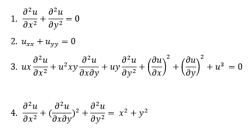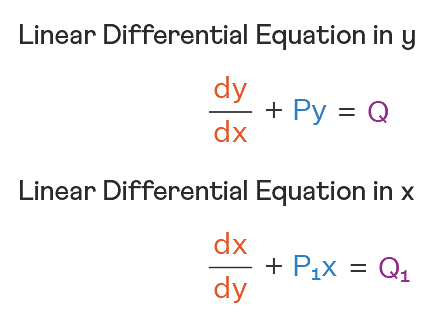If \(b_n= ∫_0^{\frac{π}{2}} \frac{cos^2nx}{sinx }dx, n∈N,\) Then
- b3 – b2, b4 – b3, b5 – b4 are in an A.P. with a common difference –2
- \(\frac{1}{b_3-b_2},\frac{1}{b_4-b_3},\frac{1}{b_5-b_4}, \text{ are in an A.P. with common difference 2}\)
- b3 – b2, b4 – b3, b5 – b4 are in a G.P.
- \(\frac{1}{b_3-b_2},\frac{1}{b_4-b_3},\frac{1}{b_5-b_4}, \text{ are in an A.P. with common difference -2}\)
The Correct Option is A
Solution and Explanation
The correct option is(D): \(\frac{1}{b_3-b_2},\frac{1}{b_4-b_3},\frac{1}{b_5-b_4}, \text{ are in an A.P. with common difference -2}\)

are in A. P. with common difference –2.
Top Questions on Differential equations
- If $ x + \frac{1}{x} = 4 $, find the value of $ x^4 + \frac{1}{x^4} $.
- BITSAT - 2025
- Mathematics
- Differential equations
- If $ a, b $ are roots of the equation $ x^2 - 5x + 6 = 0 $, find the value of $ a^3 + b^3 $.
- BITSAT - 2025
- Mathematics
- Differential equations
- If 'a' and 'b' are the order and degree respectively of the differentiable equation \[ \frac{d^2 y}{dx^2} + \left(\frac{dy}{dx}\right)^3 + x^4 = 0, \quad \text{then} \, a - b = \, \_ \_ \]
- KCET - 2025
- Mathematics
- Differential equations
- Let \( y = y(x) \) be the solution of the differential equation \[ \cos(x \log(\cos x))^2 \, dy + (\sin x - 3 \sin x \log(\cos x)) \, dx = 0, \quad x \in \left( 0, \frac{\pi}{2} \right) \] If \( y\left( \frac{\pi}{4} \right) = -1 \), then \( y\left( \frac{\pi}{6} \right) \) is equal to:
- JEE Main - 2025
- Mathematics
- Differential equations
- Let \( y = y(x) \) be the solution of the differential equation \( \frac{dy}{dx} + 3(\tan^2 x) y + 3y = \sec^2 x \), with \( y(0) = \frac{1}{3} + e^3 \). Then \( y\left(\frac{\pi}{4}\right) \) is equal to
- JEE Main - 2025
- Mathematics
- Differential equations
Questions Asked in JEE Main exam
- Ice at \( -5^\circ C \) is heated to become vapor with temperature of \( 110^\circ C \) at atmospheric pressure. The entropy change associated with this process can be obtained from:
- JEE Main - 2025
- Thermodynamics
- Let C be the circle of minimum area enclosing the ellipse E: \( \frac{x^2}{a^2} + \frac{y^2}{b^2} = 1 \) with eccentricity \( \frac{1}{2} \) and foci \( (\pm 2, 0) \). Let PQR be a variable triangle, whose vertex P is on the circle C and the side QR of length 29 is parallel to the major axis and contains the point of intersection of E with the negative y-axis. Then the maximum area of the triangle PQR is:
- JEE Main - 2025
- Coordinate Geometry
- Let circle $C$ be the image of
$$ x^2 + y^2 - 2x + 4y - 4 = 0 $$
in the line
$$ 2x - 3y + 5 = 0 $$
and $A$ be the point on $C$ such that $OA$ is parallel to the x-axis and $A$ lies on the right-hand side of the centre $O$ of $C$.
If $B(\alpha, \beta)$, with $\beta < 4$, lies on $C$ such that the length of the arc $AB$ is $\frac{1}{6}$ of the perimeter of $C$, then $\beta - \sqrt{3}\alpha$ is equal to: 0.01 mole of an organic compound (X) containing 10% hydrogen, on complete combustion, produced 0.9 g H₂O. Molar mass of (X) is ___________g mol\(^{-1}\).
- JEE Main - 2025
- Organic Chemistry
- In the Claisen-Schmidt reaction to prepare dibenzalacetone from 5.3 g benzaldehyde, a total of 3.51 g of product was obtained. The percentage yield in this reaction was _____.
- JEE Main - 2025
- Reaction Mechanisms & Synthesis
Concepts Used:
Types of Differential Equations
There are various types of Differential Equation, such as:
Ordinary Differential Equations:
Ordinary Differential Equations is an equation that indicates the relation of having one independent variable x, and one dependent variable y, along with some of its other derivatives.
\(F(\frac{dy}{dt},y,t) = 0\)
Partial Differential Equations:
A partial differential equation is a type, in which the equation carries many unknown variables with their partial derivatives.

Linear Differential Equations:
It is the linear polynomial equation in which derivatives of different variables exist. Linear Partial Differential Equation derivatives are partial and function is dependent on the variable.

Homogeneous Differential Equations:
When the degree of f(x,y) and g(x,y) is the same, it is known to be a homogeneous differential equation.
\(\frac{dy}{dx} = \frac{a_1x + b_1y + c_1}{a_2x + b_2y + c_2}\)
Read More: Differential Equations